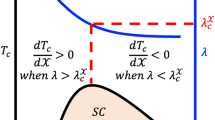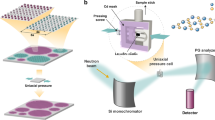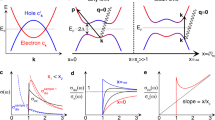Abstract
Hwang et al. reply - Our optical technique has the advantage of being a bulk probe, which is less subject to uncertainties in the doping level and in the quality of the surface than ARPES. It is also capable of higher energy resolution and the overall noise level is lower. The disadvantage is that it gives momentum-averaged properties.
Similar content being viewed by others
Main
In light of these differences, it came as a surprise to us that our reported optical self-energies1 were able to track in accurate detail the ARPES self-energies of Johnson et al.2. Our data indicate that, as a function of doping, not only could both optical and ARPES techniques resolve the sharp mode from the background but also that the sharp-mode intensity decreases uniformly, disappearing completely at a doping level of 0.23. As superconductivity is still strong at this doping level, with a Tc of 55 K, we conclude that the sharp mode is not an important contributor to high-temperature superconductivity.
Cuk et al.3 make the points that optical data may be insensitive to strongly momentum-dependent signals because they are momentum-averaged, and also that in their ARPES data4 for momenta near the antinodal point (π, 0), the sharp resonance persists in the highly overdoped region and does not disappear as we claim.
Although the measurements of Johnson et al.2 were performed at the nodal point, the weakening of the resonance also takes place at the antinodal point, as indicated by other ARPES work5. As shown in Fig. 2, self-energy effects at (π, 0) are strongly doping dependent, joining the normal-state background at a doping level of 0.24 — just as they do in our optical results and in the ARPES data of Johnson et al.2 at the nodal point. All three experiments show the same strong doping dependence.
Squares, superconducting state; circles, normal state; open symbols, bonding band; filled symbols, antibonding band. Dashed lines are straight-line fits to the data. Horizontal bar, experimental error in the dopant concentration. Reprinted with permission from ref. 5; copyright (2003) of the American Physical Society.
It is therefore surprising that the work of Gromko et al.4 fails to confirm these results. These authors do not present doping-dependent plots of the self-energy, but a visual inspection of Fig. 2 of ref. 4 suggests that the self-energy effects are almost doping independent — in contrast to the marked doping dependence reported by Kim et al.5. One reason for the disagreement may be the difficulty in controlling the doping level in the surface layers under the ultra-high-vacuum conditions used in the ARPES experiments.
References
Hwang, J., Timusk, T. & Gu, G. D. Nature 427, 714–717 (2004).
Johnson, P. D. et al. Phys. Rev. Lett. 87, 177007 (2001).
Cuk, T., Shen, Z.-X., Gromko, A. D., Sun, Z. & Dessau, D. S. Nature doi:10.1038/nature03163 (2004).
Gromko, A. D. et al. Phys. Rev. B 68, 174520 (2003).
Kim, T. K. et al. Phys. Rev. Lett. 91, 167002 (2003).
Author information
Authors and Affiliations
Corresponding author
Additional information
American Physical Society material: Readers may view, browse, and/or download material for temporary copying purposes only, provided these uses are for noncommercial personal purposes. Except as provided by law, this material may not be further reproduced, distributed, transmitted, modified, adapted, performed, displayed, published, or sold in whole or part, without prior written permission from the publisher.
Rights and permissions
About this article
Cite this article
Hwang, J., Timusk, T. & Gu, G. Sharp-mode coupling in high-Tc superconductors (reply). Nature 432, 1 (2004). https://doi.org/10.1038/nature03164
Published:
Issue Date:
DOI: https://doi.org/10.1038/nature03164
Comments
By submitting a comment you agree to abide by our Terms and Community Guidelines. If you find something abusive or that does not comply with our terms or guidelines please flag it as inappropriate.




